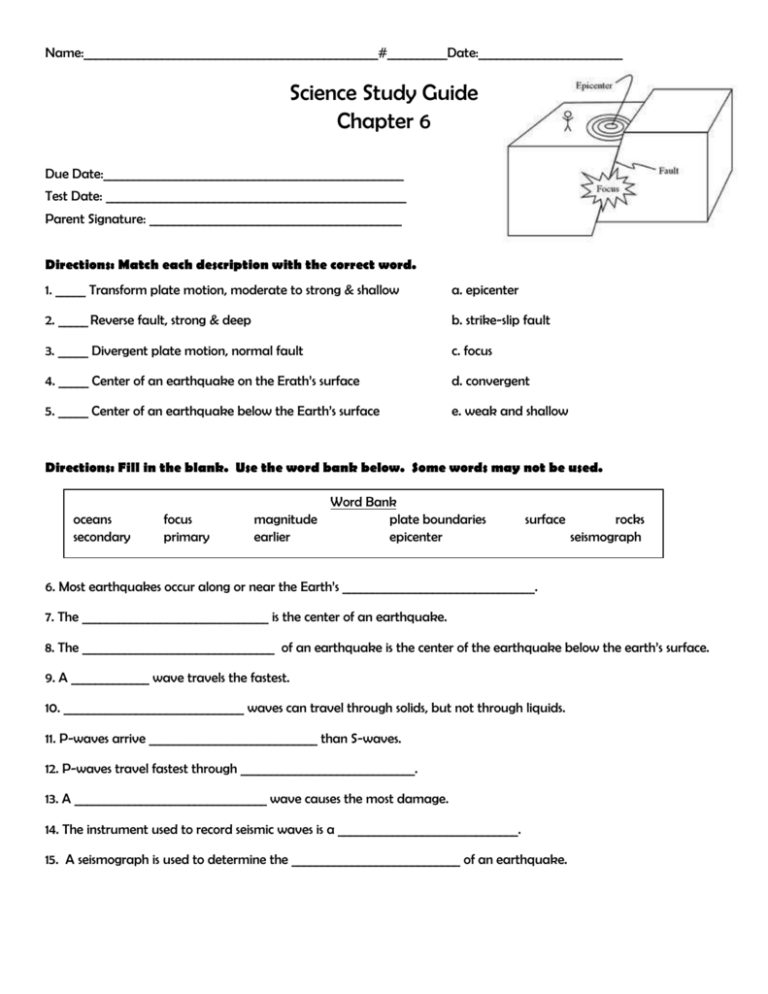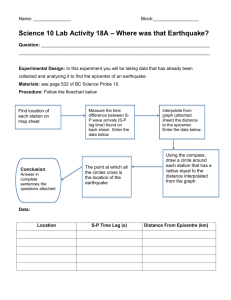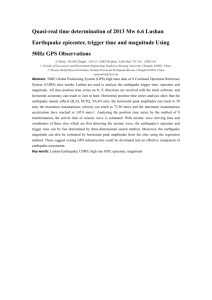Name: #__________Date: Science Study Guide Chapter 6 Due
advertisement

Name:_________________________________________________#__________Date:________________________ Science Study Guide Chapter 6 Due Date:__________________________________________________ Test Date: __________________________________________________ Parent Signature: __________________________________________ Directions: Match each description with the correct word. 1. _____ Transform plate motion, moderate to strong & shallow a. epicenter 2. _____ Reverse fault, strong & deep b. strike-slip fault 3. _____ Divergent plate motion, normal fault c. focus 4. _____ Center of an earthquake on the Erath’s surface d. convergent 5. _____ Center of an earthquake below the Earth’s surface e. weak and shallow Directions: Fill in the blank. Use the word bank below. Some words may not be used. oceans secondary focus primary magnitude earlier Word Bank plate boundaries epicenter surface rocks seismograph 6. Most earthquakes occur along or near the Earth’s ________________________________. 7. The _______________________________ is the center of an earthquake. 8. The ________________________________ of an earthquake is the center of the earthquake below the earth’s surface. 9. A _____________ wave travels the fastest. 10. ______________________________ waves can travel through solids, but not through liquids. 11. P-waves arrive ____________________________ than S-waves. 12. P-waves travel fastest through _____________________________. 13. A ________________________________ wave causes the most damage. 14. The instrument used to record seismic waves is a ______________________________. 15. A seismograph is used to determine the ____________________________ of an earthquake. Directions: Choose the best answer to each question. 16. How many seismograph recordings are needed to locate the epicenter of an earthquake? a. one b. two c. three d. four 17. How much more energy is released by an earthquake with a magnitude of 3.0 than by an earthquake with a magnitude of 2.0? a. 30 times more energy b. 250 times more energy c. 100,000 times more energy 18. The Moment Magnitude Scale is based on the a. location of an earthquake’s focus b. amount of energy released during an earthquake c. the epicenter 19. When a building is on unstable ground during an earthquake, which earthquake hazard is this? a. liquefaction b. fire c. tsunami 20. What is the most common hazard following an earthquake? a. landslides b. fires c. liquefaction 21. Look at the picture below. Which spot on the seismogram shows the arrival of the S wave? a. 1 b. 2 c. 3 d. 4 22. Circle the letter represents the epicenter. A B 23. Which earthquake hazard occurred to this building? a. tsunami b. liquefaction c. landslide d. fire 24. What is another name for a seismic sea wave? a. tsunami b. liquefaction c. landslide d. fire C D







